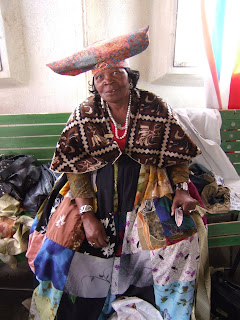
Our last week has been about language and how to learn a new language. We have not spent the week learning the language for the town we are going to (that will come later once we get to Rundu) but of one of the many tribal languages spoken in Windhoek called Oshiherero. This is the language of the Herero tribe that was almost annihilated by the Germans. So we would spend our afternoons in the Katatura area (the slums outside of Windhoek) hanging out with them and eating their delicious fresh beef. The picture of the woman with the head piece is the traditional dress for a Herero woman. Whereas the picture of the naked women is the traditional dress for the Himba tribe (the difference between the two picture is that I had to pay big bucks to get pictures of the Himba and it was free to get pictures of the Herero!)

One morning we went to go visit Hanna-Lee and her family (3 daughters and a granddaughter) in the slums. She and her family are HIV positive, and she is a former prostitute. She was rejected by her family but has come to understand the love and grace of God and has given up prostitution and tries to encourage other women (as well as her daughters) to also give up selling themselves to men. We had the chance to hear her amazing story and Suzanne meets with this family weekly to offer help and counsel. She lives each day not knowing how to feed her family and although she lives in desperate conditions we were touched by her peaceful heart. Her road is not easy.
If you would like to see more pictures of our time in Windhoek then just click on this link:
http://www.facebook.com/album.php?aid=22474&l=b4376&id=518018255




